|
|
Creator | Title | Description | Subject | Date |
| 1 |
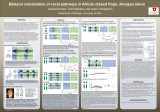 |
Yamaguchi, Ayako | Bilateral coordination of vocal pathways in African clawed frogs, Xenopus laevis | This poster describes how bilateral coordination of motor programs are achieved in the central vocal pathways of African clawed frogs. | Vocalizations; Central pattern generator; Motor programs; Bilateral coordination | 2014 |
| 2 |
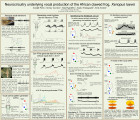 |
Yamaguchi, Ayako | Neurocircuitry underlying vocal production of the African clawed frog, Xenopus laevis | This poster describes how motor and premotor neurons are interconnected to each other using electrophysiological and pharmacological techniques. | Vocalizations; Central pattern generator; Motor programs; Premotor neurons; Whole-cell patch-clamp recordings | 2014 |
| 3 |
 |
Varner, Johanna M.; Dearing, Maria-Denise | Research data to accompany Varner and Dearing 2014 "Relevant Microclimates and Habitat Suitability" | Data package to accompany "Relevant Microclimates and Habitat Suitability". Package contains a ReadMe file and the following Excel spreadsheets: Elevation Comparison, Moss Transplant Data, Tempdata by site, Variogram-Ambient, Variogram_Ambient Shortrange, Variogram-Surf, Variogram-Talus. | Research data; Relevant microclimates; Habitat suitability | 2014 |
| 4 |
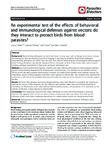 |
Clayton, Dale H. | An experimental test of the effects of behavioral and immunological defenses against vectors: do they interact to protect birds from blood parasites? | Background: Blood-feeding arthropods can harm their hosts in many ways, such as through direct tissue damage and anemia, but also by distracting hosts from foraging or watching for predators. Blood-borne pathogens transmitted by arthropods can further harm the host. Thus, effective behavioral and im... | | 2014-01-01 |
| 5 |
 |
Parkinson, John Stansfield | An unorthodox sensory adaptation site in the E. coli serine chemoreceptor | The serine chemoreceptor of E. coli contains four canonical methylation sites for sensory adaptation that lie near inter-subunit helix interfaces of the Tsr homodimer. An unexplored fifth methylation site, E502, lies at an intra-subunit helix interface, closest to the HAMP domain that controls input... | | 2014-01-01 |
| 6 |
 |
Hughes, Kelly T. | ATPase-Independent Type-III Protein Secretion in Salmonella enterica | Type-III protein secretion systems are utilized by gram-negative pathogens to secrete building blocks of the bacterial flagellum, virulence effectors from the cytoplasm into host cells, and structural subunits of the needle complex. The flagellar type-III secretion apparatus utilizes both the energy... | | 2014-01-01 |
| 7 |
 |
Jorgensen, Erik | Axon regeneration genes identified by RNAi screening in C. elegans | Axons of the mammalian CNS lose the ability to regenerate soon after development due to both an inhibitory CNS environment and the loss of cell-intrinsic factors necessary for regeneration. The complex molecular events required for robust regeneration of mature neurons are not fully understood, part... | | 2014-01-01 |
| 8 |
 |
Hughes, Kelly T. | Bacterial flagellin-specific chaperone FliS interacts with anti-sigma factor FlgM | Flagella are extracellular organelles that propel bacteria. Each flagellum consists of a basal body, a hook, and a filament. The major protein of the filament is flagellin. To prevent premature polymerization of newly synthesized flagellin molecules, FliS, the flagellin-specific chaperone, binds fla... | | 2014-01-01 |
| 9 |
 |
Coley, Phyllis D. | Chemical and bioactive natural products from microthyriaceae sp., an endophytic fungus from a tropical grass | In screening for natural products with antiparasitic activity, an endophytic fungus, strain F2611, isolated from above-ground tissue of the tropical grass Paspalum conjugatum (Poaceae) in Panama, was chosen for bioactive principle elucidation. Cultivation on malt extract agar (MEA) followed by bioas... | | 2014-01-01 |
| 10 |
 |
Olivera, Baldomero M. | Combined proteomic and transcriptomic interrogation of the venom gland of conus geographus uncovers novel components and functional compartmentalization | Cone snails are highly successful marine predators that use complex venoms to capture prey. At any given time, hundreds of toxins (conotoxins) are synthesized in the secretory epithelial cells of the venom gland, a long and convoluted organ that can measure 4 times the length of the snail's body. In... | | 2014-01-01 |
| 11 |
 |
Clayton, Dale H. | Darwins finches combat introduced nest parasites with fumigated cotton | Introduced parasites are a threat to biodiversity when naïve hosts lack effective defenses against such parasites [1]. Several parasites have recently colonized the Galápagos Islands, threatening native bird populations [2]. For example, the introduced parasitic nest fly Philornis downsi (Diptera:... | | 2014-01-01 |
| 12 |
 |
Adler, Frederick R. | Deconvolution of isotope signals from bundles of multiple hairs | Segmental analysis of hair has been used in diverse fields ranging from forensics to ecology to measure the concentration of substances such as drugs and isotopes. Multiple hairs are typically combined into a bundle for segmental analysis to obtain a high-resolution series of measurements. Individua... | | 2014-01-01 |
| 13 |
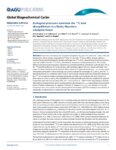 |
Bowling, David R. | Ecological processes dominate the 13C land disequilibrium in a Rocky Mountain subalpine forest | Fossil fuel combustion has increased atmospheric CO2 by ≈ 115 μmol mol1 since 1750 and decreased its carbon isotope composition (δ13C) by 1.7-2‰(the 13C Suess effect). Because carbon is stored in the terrestrial biosphere for decades and longer, the δ13C of CO2 released by terrestrial ecosyst... | | 2014-01-01 |
| 14 |
 |
Hughes, Kelly T. | The effect of cell growth phase on the regulatory cross-talk between flagellar and Spi1 virulence gene expression | The flagellar regulon controls Salmonella biofilm formation, virulence gene expression and the production of the major surface antigen present on the cell surface: flagellin. At the top of a flagellar regulatory hierarchy is the master operon, flhDC, which encodes the FlhD4C2 transcriptional complex... | | 2014-01-01 |
| 15 |
 |
Hughes, Kelly T. | The effects of codon context on in vivo translation speed | We developed a bacterial genetic system based on translation of the his operon leader peptide gene to determine the relative speed at which the ribosome reads single or multiple codons in vivo. Low frequency effects of so-called ‘‘silent'' codon changes and codon neighbor (context) effects could... | | 2014-01-01 |
| 16 |
 |
Hughes, Kelly T. | FliT selectively enhances proteolysis of FlhC Subunit in FlhD4C2 complex by an ATP-dependent protease, ClpXP | We previously reported that the ClpXP ATP-dependent pro-tease specifically recognizes and degrades the flagellar master transcriptional activator complex, FlhD 4C2, to negatively control flagellar biogenesis. The flagellum-related protein, FliT, isalso a negative regulator of flagellar regulon by in... | | 2014-01-01 |
| 17 |
 |
Parkinson, John Stansfield | HAMP domain structural determinants for signalling and sensory adaptation in Tsr, the E. coli serine chemoreceptor | Motile Escherichia coli cells track chemical gradients with high sensitivity over wide concentration ranges [recently reviewed in (Hazelbauer et al., 2008; Hazelbauer & Lai, 2010)]. Stimulus detection, amplification, and integration occur in an arrayed network of signaling complexes that contain tra... | | 2014-01-01 |
| 18 |
 |
Bowling, David R. | Impacts of anthropogenic emissions and cold air pools on urban to montane gradients of snowpack ion concentrations in the Wasatch Mountains, Utah | Urban montane valleys are often characterized by periodic wintertime temperature inversions (cold air pools) that increase atmospheric particulate matter concentrations, potentially stimulating the deposition of major ions to these snow-covered ecosystems. We assessed spatial and temporal patterns o... | | 2014-01-01 |
| 19 |
 |
Sekercioglu, Cagan | Importance of Ethiopian shade coffee farms for forest bird conservation | Coffee is the most important tropical commodity and is grown in high-priority areas for biological conservation. There is abundant literature on the conservation value of coffee farms internationally, but there has been little research on this topic in Africa. Ethiopia is a diverse and little-studie... | | 2014-01-01 |
| 20 |
 |
Jorgensen, Erik | Interferometric localization microscopy | Interference of signal in Fourier space, emitted from single probes, is used to localize it by recording and computing the phase of the fringes. Such system has applications in super resolution localization microscopy. | | 2014-01-01 |
| 21 |
 |
Sekercioglu, Cagan | Keystone species in seed dispersal networks are mainly determined by dietary specialization | One central issue in Ecology ecology has been the definition and identification of keystone species, i.e., species that are relatively more important than others for maintaining the structure of a community. Several keystone species concepts have been proposed, and network theory has been pointed o... | | 2014-01-01 |
| 22 |
 |
Beckerle, Mary C. | LIM proteins in actin cytoskeleton mechanoresponse | The actin cytoskeleton assembles into branched networks or bundles to generate mechanical force for critical cellular processes such as establishment of polarity, adhesion, and migration. Stress fibers are contractile, actomyosin structures that physically couple to the extracellular matrix through ... | | 2014-01-01 |
| 23 |
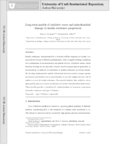 |
Adler, Frederick R. | Long-term models of oxidative stress and mitochondrial damage in insulin resistance progression | Insulin resistance, characterized by a reduced cellular response to insulin, is a major factor in type 2 diabetes pathogenesis, with a complex etiology consisting of a combination of environmental and genetic factors. Oxidative stress, which develops through an accumulation of toxic reactive oxygen ... | | 2014-01-01 |
| 24 |
 |
Beckerle, Mary C. | Mathematical modeling of the dynamic mechanical behavior of neighboring sarcomeres in actin stress fibers | Actin stress fibers (SFs) in live cells consist of series of dynamic individual sarcomeric units. Within a group of consecutive SF sarcomeres, individual sarcomeres can spontaneously shorten or lengthen without changing the overall length of this group, but the underlying mechanism is unclear. We us... | | 2014-01-01 |
| 25 |
 |
Capecchi, Mario R. | Modeling alveolar soft part sarcomagenesis in the mouse: a role for lactate in the tumor microenvironment | Alveolar soft part sarcoma (ASPS), a deadly soft tissue malignancy with a predilection for adolescents and young adults, associates consistently with t(X;17) translocations that generate the fusion gene ASPSCR1-TFE3. We proved the oncogenic capacity of this fusion gene by driving sarcomagenesis in m... | | 2014-01-01 |

























